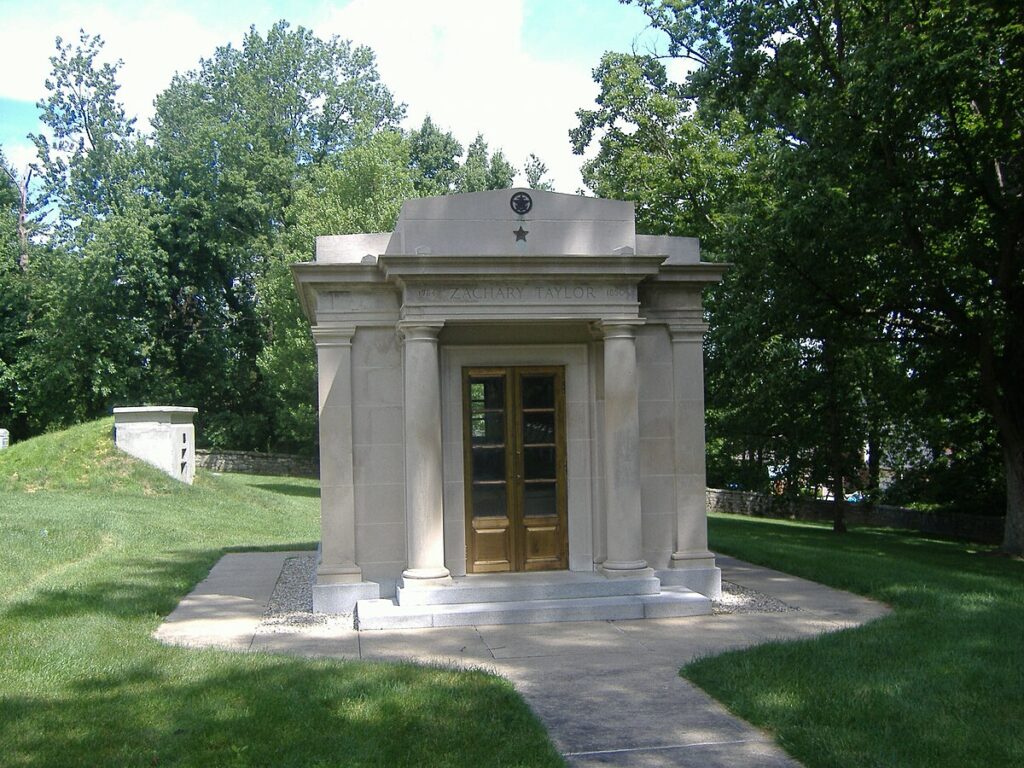Erik Visits an American Grave, Part 391
This is the grave of Zachary Taylor.
Born in Orange County, Virginia to the Virginia plantation elite, Taylor’s father Richard Taylor moved the family when Zachary was young to fresh lands near what became Louisville, Kentucky. He joined the military in 1808 and was promoted to captain in 1810. He bought plantations in Kentucky and Mississippi and became a major slaveholder. During the War of 1812, he served mostly in Indiana, fighting the British-Native alliance personified by the work of Tecumseh in uniting the region’s tribes against the continued American advance into their lands. In fact, Taylor received his first major accolades for defending Fort Harrison by an attack from Tecumseh and his warriors. He spend the years after the war in various military posts and buying more land and slaves. He made his main plantation near Baton Rouge, Louisiana and moved his family there. His daughter married the future traitor Jefferson Davis over his wishes but she died just a few months later. He fought in the Black Hawk War, one of the many wars of extermination against Native tribes during these years. Too often, we blame Andrew Jackson for Indian Removal, and rightfully so, but it was a truly national project.
Taylor’s fame came from the Mexican War, when the United States stole half of Mexico in an unjust war to expand slavery. Taylor’s men marched to the Rio Grande. Now, everyone knew that the boundary between Texas and Mexico was the Nueces River. But expansionist Texans–the same people who said their state should extend all the way to Albuquerque and up to near what is today Cheyenne, Wyoming–decided it should go to the Rio Grande. James Polk was happy to accept this. Mexico was very much not. So when Taylor marched down there, it was a provocation to war. When Mexican troops attacked–at the Battle of Palo Alto and the Battle of Rescata de la Palma–Taylor defeated them, even though he was outmanned both times. This made him a national hero. It also freaked out Polk, who feared that Taylor would get all the credit for the war and threaten him politically, as newspapers were talking about Taylor as the next Washington and Jackson and hoping he would be president. So Polk kept Taylor bottled up in the north and had Winfield Scott lead the military into the heart of Mexico. But Taylor got back in the headlines by defeating Santa Anna in the Battle of Buena Vista in 1847.
Taylor had never expressed political beliefs, but lots of people wanted him to be president anyway. For that matter, he had never voted. Ever. As it turned out, he believed in a strong banking system, thought Jackson’s bank war was a disaster, and was a strong nationalist, opposing the southern secessionist thought that was already bubbling among extremists. So, he ran as a Whig. Now, a lot of northern Whigs were outraged that their party would nominate a slaveholder to be president, even though Taylor had sad he would not have vetoed the Wilmot Proviso, which would have made it law that any territory acquired from Mexico not have slavery, had it passed Congress. So Millard Fillmore was the VP to mollify those northerners. At the same time, Martin Van Buren’s fury at being squeezed out of the nomination in 1844 by Polk’s people and the growing pro-slavery extremism of the Democratic Party convinced him to run at the head of the Free Soil Party, even though he really didn’t oppose slavery. And while that might have drawn Whig votes from Taylor, and no doubt did, it also took a lot of New York votes from Democratic nominee Lewis Cass, just because of Van Buren’s popularity in his home state. Thus, Taylor won New York and the election.
Taylor walked into a political firestorm over the land he helped conquer. Would it be slave or free? As a southerner, one might have thought Taylor would have been pretty hardcore pro-slavery expansion, but he really wasn’t. He was angry with the southern nationalists, considering them a real threat to the nation, and so started siding with northerners. He wanted to allow California to enter the nation directly as a state and thus avoid any congressional say over that state’s future. He rejected Texas’ ridiculous land claims. In fact, he threatened to lead the U.S. Army to New Mexico and lead it himself to protect them from the Texas claims. He also told the Mormons in Utah he would basically leave them alone. In short, he probably would have been a pretty good president. But then he dropped dead in 1850, before what became the Compromise of 1850 was finalized. People have long wondered why. Some said he ate too much fruit and milk at a ceremony to raise money for the Washington Monument. But he probably contracted cholera, which was all too common in 1849 and 1850.
Zachary Taylor is buried at the Zachary Taylor National Cemetery, Louisville, Kentucky.
This grave visit was funded by LGM reader contributions. I am extremely grateful for all of them. If you would like this series to visit other presidents, you can donate to cover the required expenses here. William Henry Harrison is in North Bend, Ohio and Andrew Johnson is in Greeneville, Tennessee. Previous posts in this series are archived here.





